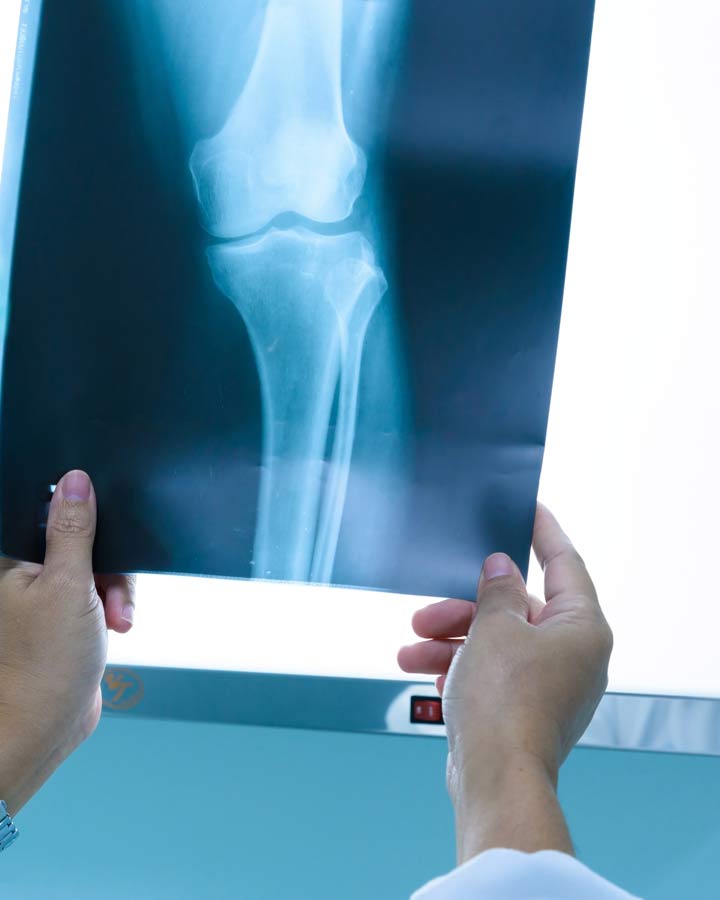More than half of all adults and three quarters of those age 65 and older in the U.S. suffer from a musculoskeletal disease, making it one of the top reasons patients seek help from hospitals, doctors, and allied health professionals. However, as the world reacted to the spread of COVID-19, many patients were unable to receive (or delayed) needed care. Today, with the pandemic still a reality, healthcare providers across the U.S. are responding to pent up demand and, where allowed, performing elective surgeries. In the midst of the challenges, health systems and physician groups are responding to five trends that have shaped orthopedic care in the U.S. in recent years.
Trends That Impact Orthopedic Care
1. HIGHER DEMAND FOR ORTHOPEDIC SURGERY AND ADJUNCT SERVICES
As the U.S. population ages, it is also getting heavier. This combination means demand in orthopedics will grow for the next two decades in the U.S., especially in outpatient settings. In tandem, public interest in health and wellbeing, the prevalence of chronic diseases, and decrease in physical activity are offering opportunities for orthopedic services beyond the procedures they perform. Looking ahead, the demand from younger patients, plus opportunities in rehab, physical therapy, functional wellbeing, arthritis and workplace health will expand the orthopedic market with supplementary services in addition to growing surgical procedures.
High
Demand
Clinical
Innovations
Cost
Control
Regulatory
Compliance
Consumer
Experience
2. CLINICAL INNOVATIONS THAT IMPROVE CLINICAL PROCESSES, INCREASE EFFICIENCY AND SHIFT SERVICES TO OUTPATIENT SETTINGS
Orthopedics is a hotbed for clinical innovation. Evidence-based innovations traverse the continuum of orthopedic services for spine, upper extremities (shoulder, elbow, wrists, and fingers) and lower extremities (foot and ankle devices). Examples include: orthobiologics, augmented reality, virtual reality, smart implants, composite tissue allograft, computer assisted surgery, bone allographic grafting, 3D printing for implant production, and more. In tandem, administrative process improvements have been integrated into scheduling. This has led to reduced cancellation rates and pain management.
The combined impact of these innovations has been a shift of surgical cases to outpatient settings. In the past five years, orthopedic outpatient procedures have increased by more than 25 percent while inpatient procedures have decreased by 3 percent. Looking ahead, this trend is likely to continue as ambulatory surgery centers and clinics become the predominant sites for care. Orthopedic services will also extend to workplaces, schools and homes to leverage health monitoring devices and digital connectivity. Facility modernization to foster a bricks and clicks model will thus be a major differentiator for orthopedic providers.
3. INCREASED PRESSURE FROM PAYERS TO CONTROL COSTS
Private insurers and large employers pay close attention to orthopedics. Demand for orthopedic services in the working age population is significant. As the cost is closely monitored in turn, several considerations include:
- Medicare launched the Comprehensive Care for Joint Replacement (CCJR) program in 2016 as part of its Bundled Payment program (BPCI). Forty-one percent of orthopedic surgeons have participated to date, saving Medicare $1,166 per case. Last month, the Centers for Medicare & Medicaid Services (CMS) announced it would reimburse total joint procedures in outpatient surgery settings—additional evidence of CMS selective attention to orthopedics. It will save Medicare $935 per case and improve margins for ASC operators by 26 percent due to lower costs for nursing care, PACU and drug therapies in outpatient settings.
- Major employers like Walmart, Boeing, Loews and others have negotiated carve-outs with provider organizations for spine surgery, total joints and other procedures. In most cases, these employers negotiate for a bundled payment rate that is based on a reference price and guarantee of outcomes. They do so to save money on health costs for their employees and dependents. For example, Walmart saved $32,000 per case on its spine surgeries by carving out its coverage with high-performing networks of providers. The result after three years: 54 percent of surgical cases were avoided via alternative treatments and 46 percent had surgery.

Looking ahead, large self-insured employers and private insurers will pursue carve-out arrangements for high-cost orthopedic procedures using referenced pricing and total cost of care as their basis for payment. Medicare will make its total joint-bundled payment program mandatory. Providers will be required to take financial risks, and Medicaid managed care organizations will be aggressive in utilization reviews and access.
4. INTENSIFIED REGULATORY COMPLIANCE RISKS FOR SURGEONS AND THEIR TEAMS
Orthopedic services are highly regulated. Specifically, the safety and efficacy of implants and devices are overseen by the U.S. Food and Drug Administration. Competition between orthopedics programs is governed by the Federal Trade Commission. Consolidation is overseen by the Department of Justice. Medicare is the major payer for orthopedic services and imposes restrictions on physician ownership and self-referral. And states control licensing of clinicians, facilities, and programs often in collaboration with independent accrediting organizations like the Joint Commission, American Association for Accreditation of Ambulatory Surgery Facilities, Inc. (AAAASF), Accreditation Association for Ambulatory Health Care (AAAHC), Institute for Medical Quality (IMQ) Health Care Facilities Accrediting Program (HFAP) and others. Looking ahead, restrictions on self-referral will be lifted so that physicians and hospitals can collaborate in risk-sharing arrangements with private payers and expand clinical capabilities. Price transparency mandates and conflict-of-interest disclosures are also expected to increase.
5. ESCALATED IMPORTANCE OF CONSUMER EXPERIENCES
Orthopedic consumers are more directly engaged than those seeking other services in healthcare. Their opinions and preferences matter. In a recent consumer choice survey, which was presented by the Advisory Board and included responses from 855 orthopedic surgery shoppers, findings indicated that:

- Thirty-five percent of adult consumers actively participated in choosing an orthopedic surgeon and 19 percent selected the surgeon themselves.
- Orthopedic consumers are regular users of report cards for physician performance and social media for self-education about therapies and procedures.
- Orthopedic consumers are price sensitive: they compare prices for surgical procedures online.
- Orthopedic consumers place great value on modern facilities and digital connectivity as both offer convenience.
These experiences factor heavily into reimbursement of CMS value-based purchasing. They also consider patient satisfaction and performance ratings for physician-sponsored private insurers from the Hospital Consumer Assessment of Healthcare Providers and Systems. As we move forward, every elective procedure or visit will be scheduled through digital platforms, plus estimated out-of-pocket costs for each test and procedure will be available to patients in advance. Additionally, physicians will utilize telehealth and e-visits to more effectively engage with patients.
As healthcare organizations try restoring some normalcy while the pandemic continues, re-engaging patients and procedures requires additional attention in the following areas:
Emergency Relief Funding
The two major sources for relief funds available to orthopedic service providers are the:
- Provider Relief Fund: A grant to practices based on their Medicare fee-for-service revenues
- Paycheck Protection Program: A forgivable loan tied to a practice’s retention of its employees. Attestation for both is based on verifiable COVID-19 expenses.
Infection Control
The punch list for an orthopedic services provider now includes protocols for masks, staff testing, contact tracing, facility disinfection, secure space for infected patients, visitation restrictions, supply/equipment sterilization and more. If you are a practitioner of orthopedic services, make sure you are implementing all the best practices to mitigate the spread of infection by visiting The American Academy of Orthopedic Surgeons’ (AAOS) website and its COVID-19 Member Resource Center.
Telehealth Integration
The use of telehealth for virtual visits and distance diagnostics is a key change in the COVID-19 environment for orthopedic service providers. A March CMS waiver allowed Medicare patients’ office visits and prescriptions to be done via telehealth even if unrelated to COVID-19. It also allowed clinicians to reduce or waive cost sharing for all telehealth visits. In addition, most private insurers announced temporary reimbursement for telehealth at Medicare rates for the balance of 2020. Technologies permitted under these telehealth provisions include:
- Skype for Business/Microsoft Teams
- Updox
- VSee
- Zoom for Healthcare
- Doxy.me
- Google Hangouts Meet
- Cisco WebEx Meetings/WebEx Teams
- Amazon Chime
- Apple FaceTime
- Whatsapp Video Chat
- GoToMeeting

The trends shaping orthopedic care in the U.S. will continue to frame future opportunities in the industry. However, the coronavirus pandemic has altered the timeframe. For the next three to six months, extraordinary attention will be given to four areas:
Financial
Solvency
Emergency relief funding, as well as optimization of efficiency and cash flow
Infection
Control
Implementation and monitoring of testing, masking and contact tracing for staff, patients and visitors
Telehealth
Integration of telehealth and virtual visits into care management protocols and day-to-day clinical operations
Patient Anxiety
Management of patient anxiety to reduce reluctance to reschedule elective procedures and visits
Considering these trends and outlooks in response to the pandemic, orthopedic services are an attractive market for investors and hospitals. Orthopedics also represent essential services in community health. Although the coronavirus created financial chaos for orthopedic providers, their longterm future remains bright.

Integrating telehealth and AI technology for accessible, effective virtual rehabilitation
Patient Anxiety
The pandemic has caused unsettling experiences across the globe. To address this, many have contacted patients via telephone or e-mail to reschedule procedures or visits. Many are extending office hours and expanding operating room schedules to accommodate additional volume. Many are also communicating with patients about infection-control policies as safety precautions. However, patient anxiety to recover from elective procedures is still lingering and needs to be managed. As this is a major challenge facing orthopedics, several observations should be considered:
- In late March 2020, as the lockdowns began, 83 percent of Americans said they were concerned about being exposed to COVID-19 in a doctor’s office or hospital. Additionally, 36 percent said that they would not go into a medical facility at all.
- In mid-May 2020, 48 percent of Americans said they, or someone in their household, postponed or skipped medical care due to the outbreak. Of these who delayed care, 68 percent expect to have delayed care in the next three months.
- As a result of COVID-19, 72 percent of U.S. consumers have dramatically changed their use of traditional healthcare services. For example, 58 percent cite their doctors as the most trusted source of information about the virus. However, only 31 percent feel comfortable visiting their doctors’ offices, while 42 percent say they feel uncomfortable going to a hospital for any kind of medical treatment.
- It is anticipated that 80 percent of cancellations for major surgical procedures will be re-captured by the end of 2020 unless a second surge of the COVID-19 virus hits later this year, but it’s not assured.
ERDMAN Takeaway
Every orthopedic practice, hospital, insurer, and supplier recognizes the significant growth opportunities in orthopedic services. However, many are also aware of the uncertain market conditions in response to COVID-19. Although the pandemic has created financial chaos for orthopedic services, its long-term future remains bright. Continually assessing patient needs and keeping them safe while staying informed about policies to strategically plan for a new normal is key. If you need guidance to chart a path forward, ERDMAN welcomes the opportunity to connect with you. Our forward-looking insight and breadth of experience has led many healthcare organizations to successful outcomes that helped improve the lives of their patients and communities.
- AAOS. (2020). “COVID-19 Member Resource Center.” Retrieved from https://www.aaos.org/about/covid-19-information-for-our-members/?utm_medium=Card&utm_ source=aaos.org&utm_campaign=COVIDhomepageRCCard&utm_content=aaos.org
- Advisory Board. (2020, February 6). “Orthopedic market trends for 2020” [PowerPoint slides]. https://www.advisory.com/research/service-line-strategy-advisor/resources/2014/orthopedic-and-spine-market-trends
- Barnett, et al. (2019, January 17). “Two-year evaluation of mandatory bundled payments for joint replacement.” Retrieved from https://www.nejm.org/doi/full/10.1056/NEJMsa1809010
- Bowser, A. (2018). “Medicare’s bundled pay plan didn’t deliver big cost savings.” Retrieved from https://www.mdedge.com/chestphysician/article/170429/pulmonology/medicares-bundled-pay-plan-didnt-deliver-big-cost-savings
- Cherf, J. (2019, September 1). ”A snapshot of U.S. orthopaedic surgeons: results from the 2018 OPUS survey.” Retrieved from https://www.aaos.org/aaosnow/2019/sep/youraaos/youraaos01/
- “COVID-19 Shifts Health Care Consumer Behavior.” (2020, June 10). Retrieved from https://protect-us.mimecast.com/s/Ov2nCNkKxNh6qQwTrmfno?domain=achp.org%2F
- Doximity. (2019, June). “U.S. physician employment report 2019: workforce trends by Metro area and medical specialty.” Retrieved from https://www.doximity.com/press_releases/physician_employment_report_2019
- Evans M. (2019, April 4). “Walmart, other employers get choosier about workers’ doctors.” Retrieved from https://www.wsj.com/articles/walmart-other-employers-get-choosier-about-workers-doctors-11554382801
- Fortune Business Insights. (2018). “Orthopedic Joint Replacement Market Size, Share, and Industry Analysis.” https://www.fortunebusinessinsights.com/industry-reports/orthopedic-joint-replacement-market-100314
- Kearney, A., Hamel, L., Kirzinger, A., Brodie, M., Muñana, C., & Lopes, L. (2020, June 03). “KFF Health Tracking Poll – May 2020 – Health and Economic Impacts.” Retrieved from https://www.kff.org/report-section/kff-health-tracking-poll-may-2020-health-and-economic-impacts/
- “Orthopedic Devices Market Research Reports, Global Industry Size, Growth Opportunity, Top Key Players Forecast to 2026.” (2020, June 11). Retrieved from https://www.marketwatch.com/press-release/orthopedic-devices-market-research-reports-global-industry-size-growth-opportunity-top-key-players-forecast-to-2026-2020-06-11?tesla=y
- Navathe, A., Liao, J., & Dykstra, S. (2018, September 04). “Association Between CMS Bundled Payment Participation and Joint Replacement Volume and Case Mix.” Retrieved from https://jamanetwork.com/journals/jama/fullarticle/2698926?resultC
- Rechtoris M. (2015, August 2). “23 statistics for orthopedic surgeons– compensation, net worth, and more.” Retrieved from https://www.beckersspine.com/orthopedic/item/26569-23-statistics-for-orthopedic-surgeons-compensation-net-worth-more.html
- Saad, L. (2020, April 08). “More Americans Delaying Medical Treatment Due to Cost.” Retrieved from https://protect-us.mimecast.com/s/MXnYCL91gLF3DglTPrChp?domain=news.gallup.com
- Udai et al. (2016, July 14). “Who Is Not a Candidate for a 1-Day Hospital-Based.” Retrieved from https://pubmed.ncbi.nlm.nih.gov/27491443/
- Woods, et al. (2019, June). “How employers are fixing health care.” Retrieved from https://hbr.org/cover-story/2019/03/how-employers-are-fixing-health-care
- Young, S. (2020, July 9). “Amid Surge, Hospitals Hesitate To Cancel Nonemergency Surgeries.” Retrieved from https://khn.org/news/amid-surge-hospitals-hesitate-to-cancel-nonemergency-surgeries/



